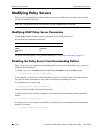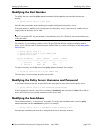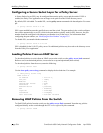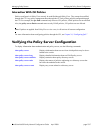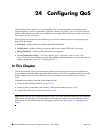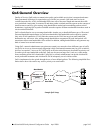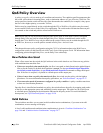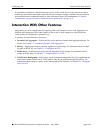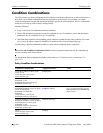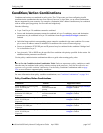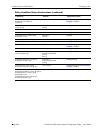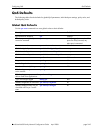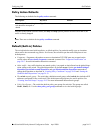
QoS Policy Overview Configuring QoS
page 24-4 OmniSwitch 6600 Family Network Configuration Guide April 2006
QoS Policy Overview
A policy (or a policy rule) is made up of a condition and an action. The condition specifies parameters that
the switch will examine in incoming flows, such as destination address or Type of Service (ToS) bits. The
action specifies what the switch will do with a flow that matches the condition; for example, it may queue
the flow with a higher priority, or reset the ToS bits.
Policies may be created directly on the switch through the CLI or WebView. Or policies may be created
on an external LDAP server via the PolicyView application. The switch makes a distinction between poli-
cies created on the switch and policies created on an LDAP server.
Note. Polices may be only be modified using the same source used to create them. Policies configured
through PolicyView may only be edited through PolicyView. Policies created directly on the switch
through the CLI or WebView may only be edited on the switch. Policies may be created through the CLI
or WebView, however, to override policies created in PolicyView. And vice versa.
This chapter discusses policy configuration using the CLI. For information about using WebView to
configure the switch, see the OmniSwitch 6600 Family Switch Management Guide. For information about
configuring policies through PolicyView, see the PolicyView online help.
How Policies Are Used
When a flow comes into the switch, the QoS software in the switch checks to see if there are any policies
with conditions that match the flow.
• If there are no policies that match the flow, the flow is accepted or denied based on the global disposi-
tion set for the switch. By default, the disposition is accept. Use the qos default bridged disposition,
qos default routed disposition, or qos default multicast disposition command to change the disposi-
tion. If the flow is accepted, it is placed in a default queue on the output port.
• If there is more than one policy that matches the flow, the switch uses the policy with the highest
precedence. For more information about policy precedence, see “Rule Precedence” on page 24-27.
• Flows must also match all parameters configured in a policy condition. A policy condition must have
at least one classification parameter.
Once the flow is classified and matched to a policy, the switch enforces the policy by mapping each packet
of the flow to the appropriate queue and scheduling it on the output port. The queue may be a QoS queue
or a default queue, depending on the information indicated in the policy action. For more information
about queues, see “QoS Ports and Queues” on page 24-20.
Valid Policies
The switch does not allow you to create invalid condition/action combinations; if you enter an invalid
combination, an error message will display.
A list of valid condition and condition/action combinations is given in “Condition Combinations” on
page 24-6 and “Condition/Action Combinations” on page 24-7.



